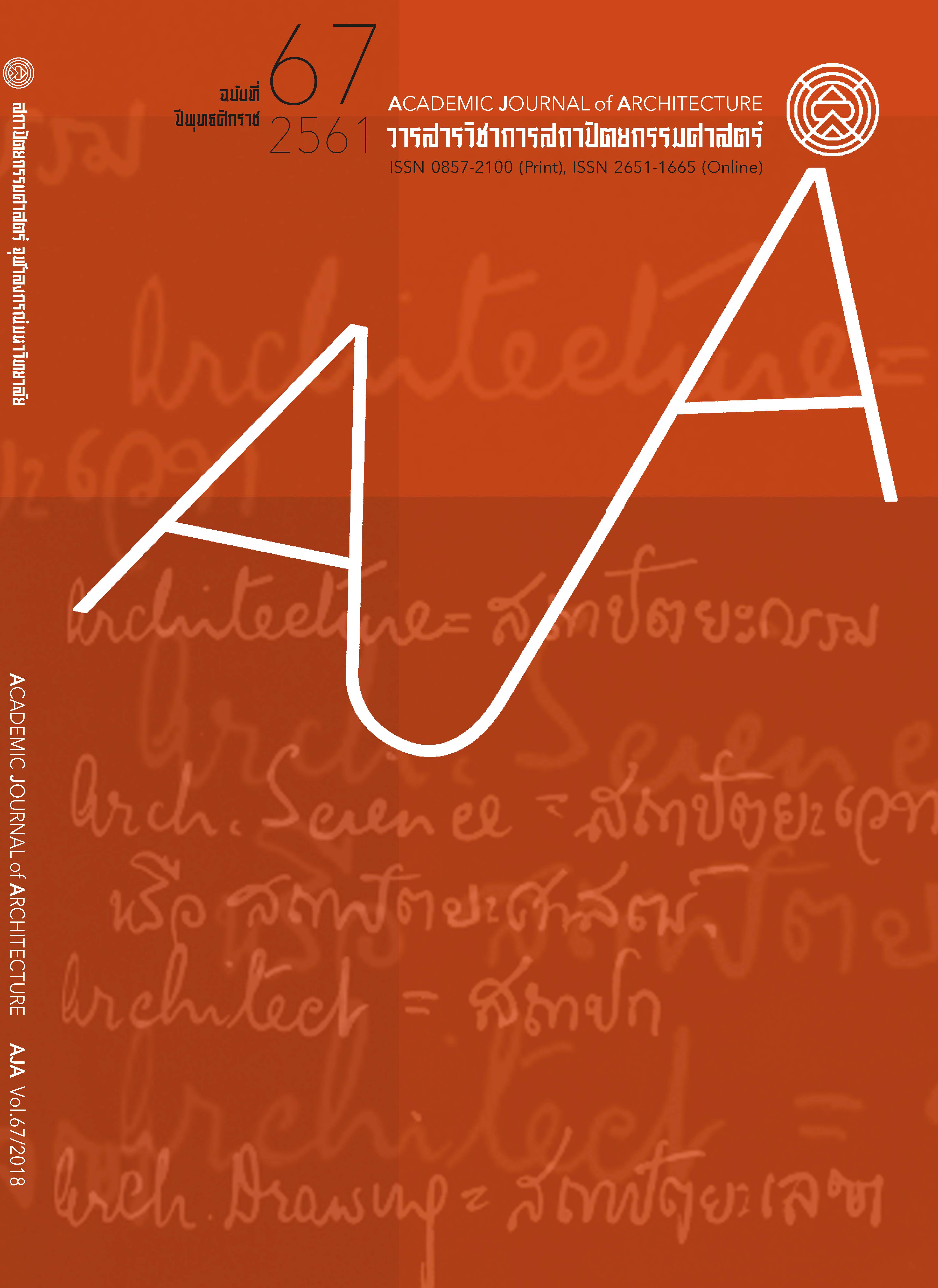Consideration for Adapting International Concept of Urban Heritage Conservation in the Context of Thailand
Main Article Content
Abstract
Concepts of urban heritage conservation in the international principles and charters have been continuously developed, from conserving historic buildings in the historic centers to the urban heritage conservation concept covering broad issues. Based on landscape approach conservation, tangible and intangible features and character-defining elements have been taken into consideration. In addition, conservation has been integrated within sustainable development.
In order to apply these international conservation concepts to the context of Thailand, this study proposes the way to apply the notion of “traditional districts and communities,” which has currently been used. However, the notion should be revised by (1) the addition of consideration of cultural values related to common heritage as well as of other values relevant to the urban development process; and (2) the respect for the distinctive characters of traditional Thai districts and communities. Additionally, the effective management of heritage sites with public involvement and the provision of management tools should also be implemented.
Article Details
References
ICOMOS. 1999. “Burra Charter The Australia ICOMOS Charter for Places of Cultural Significance.” Accessed January 5, 2016. http://australia.icomos.org/publications/charters/.
ICOMOS. 1964. “Venice Charter The International Charter for the Conservation and Restoration of Monuments and Site.” Accessed January 15, 2016. http://www.charta-von-venedig.de/venice-charter_congress-of-preservation_conservation_art.4-8_english.html.
ICOMOS. 2008. “Quibeq Declaration On Eco-Tourism.” Accessed January 15, 2016. http://www.gdrc.org/uem/eco-tour/quebec-declaration.pdf.
ICOMOS. 2011. “Valletta Principles for the Safeguarding and Management of Historic Cities, Towns and Urban Areas.” Accessed September 1, 2016. https://www.icomos.org/Paris2011/GA2011_CIVVIH_text_EN_FR_final_20120110.pdf.
ICOMOS. 2005a. “Seoul Declaration on Tourism in Asia’s Historic Towns and Areas.” Accessed November 10, 2015. https://www.icomos.org/xian2005/seoul-declaration.pdf.
ICOMOS. 2005b. “Vienna Memorandum on “World Heritage and Contemporary Architecture – Managing the Historic Urban Landscape.” Accessed September 1, 2015. http://whc.unesco.org/archive/2005/whc05-15ga-inf7e.pdf.
ICOMOS. 2005c. “Xi’an Declaration on the Conservation of the Setting of Heritage Structures, Sites and Areas.” Accessed September 1, 2015. https://www.icomos.org/xian2005/xian-declaration.htm.
ICOMOS. 2007. “Ename Charter: The ICOMOS Charter for the Interpretation and Presentation of Cultural Heritage Sites.” Accessed September 1, 2015. http://www.enamecharter.org.
ICOMOS. 2002. “Principles for the Conservation of Heritage Sites in China.” Accessed September 1, 2015. https://www.getty.edu/conservation/publications_resources/pdf_publications/pdf/china_prin_heritage_sites.pdf.
Jokilehto, J. 2010. “Notes on the Definition and Safeguarding of HUL.” City & Time 3,3: 41-51.
UNESCO. 2009. “Hoi An Protocols for the Best Conservation Practice in Asia.” Accessed January 15, 2016. http://unesdoc.unesco.org/images/0018/001826/182617e.pdf.
คณะอนุกรรมการที่ปรึกษาสิทธิมนุษยชนด้านเศรษฐกิจสังคมและวัฒนธรรม. 2558. “เอกสารการประชุมเพื่อประกอบการพิจารณากรณี ‘ย่านเก่ากับการคุ้มครองสิทธิมนุษยชน.’” ห้องประชุม 709 ชั้น 7 สำนักงานคณะกรรมการสิทธิมนุษยชนแห่งชาติ, กรุงเทพฯ, วันที่ 28 กรกฎาคม.
คณะอนุกรรมการอนุรักษ์และพัฒนาเมืองเก่า. 2560. “เอกสารประกอบการประชุมสัมมนาวิชาการ.” ณ โรงแรมรามา การ์เด้นส์, กรุงเทพฯ, วันที่ 8 มิถุนายน.
ปรานอม ตันสุขานันท์และวิทยา ดวงธิมา. 2555. แนวทางการพัฒนาความเป็นย่านหลากมิติของเมืองเชียงใหม่. เชียงใหม่: โรงพิมพ์ปู-เป้.
ปิ่นรัชฎ์ กาญจนัษฐิติ. 2552. การอนุรักษ์มรดกสถาปัตยกรรมและชุมชน. กรุงเทพฯ: โรงพิมพ์แห่งจุฬาลงกรณ์มหาวิทยาลัย.
ปิยลดา ทวีปรังษีพร. 2554. คำ ความคิด สถาปัตยกรรม. กรุงเทพฯ: ลายเส้น.
ยงธนิศร์ พิมลเสถียร. 2556a. การปรับปรุงฟื้นฟูเมืองและการอนุรักษ์เมือง. กรุงเทพฯ: สำนักพิมพ์มหาวิทยาลัยธรรมศาสตร์.
ยงธนิศร์ พิมลเสถียร. 2556b. “ประเด็นวิกฤตเรื่องการอนุรักษ์ชุมชนประวัติศาสตร์ในเมืองสำหรับประเทศไทย.” หน้าจั่ว: ว่าด้วยประวัติศาสตร์สถาปัตยกรรม และสถาปัตยกรรม ไทย 9 (กันยายน 2555-สิงหาคม 2556): 101-119.
ศรีศักร วัลลิโภดม. 2554. “การศึกษาสังคมไทยผ่าน ‘ภูมิวัฒนธรรม.’” สืบค้น 15 มกราคม 2559. http://lek-prapai.org/home/view.php?id=84.
สำนักงานนโยบายและแผนทรัพยากรธรรมชาติและสิ่งแวดล้อม. 2559. “คู่มือการอนุรักษ์สิ่งแวดล้อมศิลปกรรมประเภทย่านชุมชนเก่า.” สืบค้น 15 มกราคม 2559. http://www.onep.go.th/nced/?p=747.
สำนักงานนโยบายและแผนทรัพยากรธรรมชาติและสิ่งแวดล้อม. 2554. “ชุดความรู้ด้านการอนุรักษ์ พัฒนาและบริหารจัดการเมืองเก่า.” สืบค้น 15 มกราคม 2559. http://lib.mnre.go.th/index.php/2012-04-30-03-57-01/2012-10-12-09-13-14/234-2012-10-29-07-15-05.
อิโคโมสไทย. 2553. “กฎบัตรประเทศไทยว่าด้วยการบริหารจัดการแหล่งมรดกวัฒนธรรม.” สืบค้น 15 มกราคม 2559. https://www.icomosthai.org/THcharter/Thailand%20Charter.pdf.


